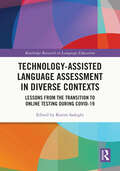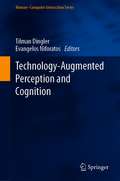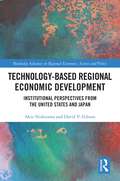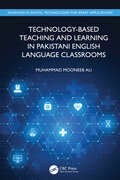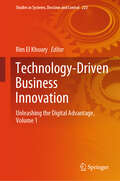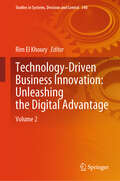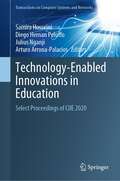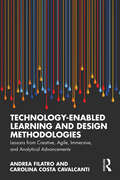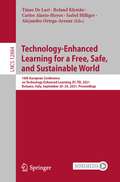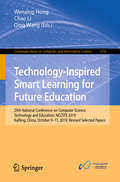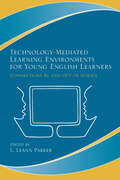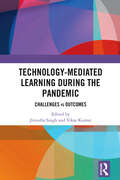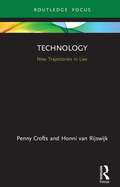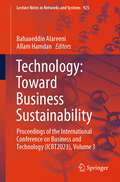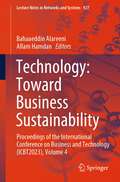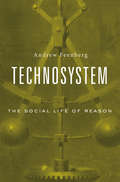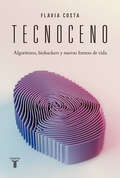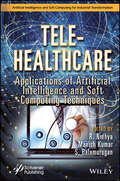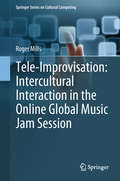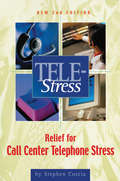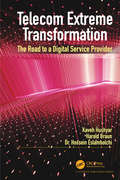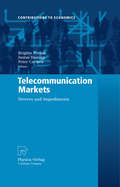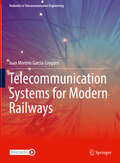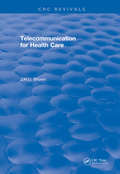- Table View
- List View
Technology-Assisted Language Assessment in Diverse Contexts: Lessons from the Transition to Online Testing during COVID-19 (Routledge Research in Language Education)
by Karim SadeghiThis timely collection explores the role of digital technology in language education and assessment during the COVID-19 pandemic. It recognises the unique pressures which the COVID-19 pandemic placed on assessment in language education, and examines the forced shift in assessment strategies to go online, the existing shortfalls, as well as unique affordances of technology-assisted L2 assessment. By showcasing international examples of successful digital and computer-assisted proficiency and skills testing, the volume addresses theoretical and practical concerns relating to test validity, reliability, ethics, and student experience in a range of testing contexts. Particular attention is given to identifying lessons and implications for future research and practice, and the challenges of implementing unplanned computer-assisted language assessment during a crisis. Insightfully unpacking the ‘lessons learned’ from COVID and its impact on the acceleration of the shift towards online course and assessment delivery, it offers important guidelines for navigating assessment in different instructional settings in times of crisis. It will appeal to scholars, researchers, educators, and faculty with interests in educational measurement, digital education and technology, and language assessment and testing.
Technology-Augmented Perception and Cognition (Human–Computer Interaction Series)
by Tilman Dingler Evangelos NiforatosTools and technologies have long complemented and extended our physical abilities: from pre-historic spearheads to steam-propelled ploughs and high-tech prosthetics. While the development of lenses granted us insights into the micro and macrocosms, new sensors and technologies increasingly augment our cognitive abilities, including memory and perception. This book integrates current research efforts, results, and visions from the fields of computer science, neuroscience, and psychology. It provides a comprehensive overview of the state-of-the-art and future applications of how technologies assist and augment human perception and cognition. Experts in the field share their research and findings on: Working memory enhancementsDigitization of memories through lifelog archivesThe consequences of technology-induced disruptions and forgettingThe creation and utilization of new human senses Ethical and security concerns that arise with augmentation technologies. As technology weaves itself ever deeper into our lives, careful examination of its capabilities, risks and benefits is warranted. While this book focuses on the complementation and augmentation of human capabilities, it serves as a foundation for students, researchers and designers of technologies that push the boundaries of perception and cognition.
Technology-Based Regional Economic Development: Institutional Perspectives from the US and Japan (Routledge Advances in Regional Economics, Science and Policy)
by David V. Gibson Akio NishizawaRegional technology-based economic development and the recruitment and retention of talent is a top priority of city-regions in the United States and in countries around the world. However, policy recommendations from government officials, industry leaders and academics are often ambiguous or are in conflict. To address these issues, this book deals with the complex intersection of institutional theory and national and regional policy initiatives.It provides an overview of United States and Japanese technology policy development at the national level with case analyses of Austin, Texas and Tsuruoka, Japan to identify key regional strategies and processes that have resulted in successful endogenous technology-based business development and job creation. It offers an innovative analytical perspective to improve our understanding of how successful tech-based regional economic development works in theory and practice. The book’s discussion is grounded on important technology paradigm shifts in the US and Japan from 1970 to 1980 leading to current realities. To address the complex “Puzzle of Space” conundrum, the authors describe similarities and differences in regional development processes in Austin and Tsuruoka. They present a generalizable model indicating necessary and sufficient conditions linked to the building of new “Small i” institutions at normative and cognitive levels of analysis in consort with regulative policy and innovations at macro level “Capital I” institutions. The book clearly explains the relations between institutions and economic growth, an important issue in contemporary economics.The book’s conclusions clarify critical success factors for endogenous regional development growth theory and lead to recommendations for policymakers who are searching for ways to achieve success.
Technology-Based Teaching and Learning in Pakistani English Language Classrooms (Advances in Digital Technologies for Smart Applications)
by Muhammad Mooneeb AliPakistan is the sixth most populous country in the world. Unexpectedly, the education system in Pakistan is quite orthodox in teaching and learning. There are numerous educational institutes in Pakistan but they are rigorously following conventions. There are problems with infrastructure, and in some areas, the basic facilities are also not there. Sometimes the classrooms are overpopulated, and sometimes there are places where no teacher is available to teach the students. There are instances where the basic infrastructure is not complete and there are no proper classrooms for teaching and learning. All these factors are causing a lot of problems for learners to compete in the modern world. English enjoys the status of official language in the country but, surprisingly, learning English is a troublesome area. There are problems not only in basic English language learning but also many second language learners face problems when they appear in international tests and competitive examinations. English language classrooms are usually boring and uninteresting. Therefore, this book is written with an aim to provide alternative solutions to the conventional methods by integrating modern technology tools in Pakistani classrooms. The scope of this book is widened for language researchers, policymakers, readers and administrators of the government to analyse some of the problems and issues mentioned in this book and develop a roadmap for better education.Some of the key elements of this book are as follows: This is the first research-based book to explore some of the latest research tools in Pakistani classrooms This book is based on research-based chapters Shows pictures of local English language classrooms Provides insights and practices for integrating modern methods in English language classrooms
Technology-Driven Business Innovation: Unleashing the Digital Advantage, Volume 1 (Studies in Systems, Decision and Control #223)
by Rim El KhouryThis book aims to provide a comprehensive understanding of the interplay between technology and business and its implications for future growth and innovation. In today's rapidly changing world, technology plays a crucial role in shaping the business landscape. Advancements in artificial intelligence, blockchain, data analytics, and automation have revolutionized how organizations operate, compete, and achieve success. Understanding the profound impact of technology on business is vital for entrepreneurs, managers, policymakers, and academics alike. This book aims to explore the connection between technology and business, highlighting its importance in driving transformative changes across various industries. We welcome scholars, researchers, and practitioners to share their expertise and insights in this exciting endeavor.This book captures the essence of exploring the dynamic relationship between technology and business, emphasizing the potential for innovation and growth. It conveys the idea of embracing the transformative power of technology within the business realm and the opportunities it presents for unleashing new ideas and strategies.By delving into various aspects such as emerging technologies, business strategies, innovation, and ethical considerations, it aims to provide a comprehensive understanding of the symbiotic relationship between technology and business. It offers insights into the integration of technology into decision-making processes, the transformative impact on different industries, and strategies for leveraging technology to drive organizational growth and sustainability.Furthermore, the book highlights real-world case studies, explores emerging trends, and discusses the ethical and social implications of technology adoption in the business context. It serves as a valuable resource for entrepreneurs, managers, policymakers, academics, and anyone interested in understanding and harnessing the potential of technology for business success. This book aims to be a valuable resource for individuals interested in the transformative power of technology in the business realm. By compiling a collection of insightful chapters, it offers readers a diverse range of perspectives, frameworks, and case studies that shed light on the complexities and opportunities associated with technology-driven business environments.
Technology-Driven Business Innovation: Volume 2 (Studies in Systems, Decision and Control #540)
by Rim El KhouryIn today's rapidly changing world, technology plays a crucial role in shaping the business landscape. Advancements in artificial intelligence, blockchain, data analytics, and automation have revolutionized how organizations operate, compete, and achieve success. Understanding the profound impact of technology on business is vital for entrepreneurs, managers, policymakers, and academics alike. This book aims to provide a comprehensive understanding of the interplay between technology and business and its implications for future growth and innovation. This book aims to explore the connection between technology and business, highlighting its importance in driving transformative changes across various industries. We welcome scholars, researchers, and practitioners to share their expertise and insights in this exciting endeavor. This title captures the essence of exploring the dynamic relationship between technology and business, emphasizing the potential for innovation and growth. It conveys the idea of embracing the transformative power of technology within the business realm and the opportunities it presents for unleashing new ideas and strategies. By delving into various aspects such as emerging technologies, business strategies, innovation, and ethical considerations, it aims to provide a comprehensive understanding of the symbiotic relationship between technology and business. It offers insights into the integration of technology into decision-making processes, the transformative impact on different industries, and strategies for leveraging technology to drive organizational growth and sustainability. Furthermore, the book highlights real-world case studies, explores emerging trends, and discusses the ethical and social implications of technology adoption in the business context. It serves as a valuable resource for entrepreneurs, managers, policymakers, academics, and anyone interested in understanding and harnessing the potential of technology for business success. This book aims to be a valuable resource for individuals interested in the transformative power of technology in the business realm. By compiling a collection of insightful chapters, it will offer readers a diverse range of perspectives, frameworks, and case studies that shed light on the complexities and opportunities associated with technology-driven business environments.
Technology-Enabled Innovations in Education: Select Proceedings of CIIE 2020 (Transactions on Computer Systems and Networks)
by Samira Hosseini Diego Hernan Peluffo Julius Nganji Arturo Arrona-PalaciosThis book contains peer-reviewed selected papers of the 7th International Conference on Educational Innovation (CIIE 2020). It presents excellent educational practices and technologies complemented by various innovative approaches that enhance educational outcomes. In line with the Sustainable Development Goal 4 of UNESCO in the 2030 agenda, CIIE 2020 has attempted to “ensure inclusive and equitable quality education and promote lifelong learning opportunities for all.” The CIIE 2020 proceeding offers diverse dissemination of innovations, knowledge, and lessons learned to familiarize readership with new pedagogical-oriented, technology-driven educational strategies along with their applications to emphasize their impact on a large spectrum of stakeholders including students, teachers and professors, administrators, policymakers, entrepreneurs, governments, international organizations, and NGOs.
Technology-Enabled Learning and Design Methodologies: Lessons from Creative, Agile, Immersive, and Analytical Advancements
by Andrea Filatro Carolina Costa CavalcantiTechnology-Enabled Learning and Design Methodologies offers a comprehensive and example-rich guide to the latest technological and methodological advancements in education. This book systematically organizes a rich variety of educational innovations into four distinct groups of teaching-learning methodologies, each with its own focus and disruptive potential:· Creative methodologies, centered on student protagonism and creativity, which shift the traditional roles in the teaching-learning process, empowering students to take an active, leading role in their education and encouraging creative thinking and expression.· Agile methodologies, focused on time management and adaptability, which optimize students’ time and attention through microlearning and other bite-sized content, activities, and assessments.· Immersive methodologies, driven by simulated real-world scenarios, which blur the boundaries between learning environments and real-life contexts in order to immerse learners in challenging, story-driven environments linked to clear learning objectives.· Analytical methodologies, based on computation power, which support personalized, adaptive, and evidence-based teaching and learning by collecting and processing student data.Through a practical, dialogical approach, filled with visual resources and real-world examples, the authors provide solid theoretical foundations for their methodologies of focus, positioning them within a broader spectrum that goes beyond mere consumption of isolated techniques or technologies. This will be a relevant resource for current and aspiring instructional designers, educational technologists, subject matter experts, teaching faculty, researchers, and other stakeholders involved in face-to-face, distance, or hybrid education.
Technology-Enhanced Learning for a Free, Safe, and Sustainable World: 16th European Conference on Technology Enhanced Learning, EC-TEL 2021, Bolzano, Italy, September 20-24, 2021, Proceedings (Lecture Notes in Computer Science #12884)
by Carlos Alario-Hoyos Roland Klemke Tinne De Laet Isabel Hilliger Alejandro Ortega-ArranzThis book constitutes the proceedings of the 16th European Conference on Technology Enhanced Learning, EC-TEL 2021, held in Bolzano, Italy, in September 2021. The 21 research full papers and 28 short papers presented in this volume were carefully reviewed and selected from 98 submissions. The European Conference on Technology-Enhance Learning, is committed to address global challenges and quality education. The papers deal with the Sustainable Development Goals, particularly SDG 4 and SDG 10, to help to reduce the existing gaps and inequalities between countries and regions from around the world in terms of inclusiveness, equity, access, and quality of education.
Technology-Inspired Smart Learning for Future Education: 29th National Conference on Computer Science Technology and Education, NCCSTE 2019, Kaifeng, China, October 9–11, 2019, Revised Selected Papers (Communications in Computer and Information Science #1216)
by Qing Wang Chao Li Wenxing HongThis book constitutes the refereed proceedings of the 29th National Conference on Computer Science Technology and Education, NCCSTE 2019, held in Kaifeng, China, in October 2019.The 12 full papers presented were thoroughly reviewed and selected from 50 submissions. The papers focus on the diverse environments of smart learning, including massive open online courses with AI assistants, intelligent tutoring systems, interactive learning courseware, learning games, collaborative programming communities, community tutorial systems, personalized exercise programs, tutoring robotics, etc. The papers are organized in the following topical sections: smart learning; information technologies.
Technology-Mediated Learning Environments for Young English Learners: Connections In and Out of School
by L. Leann ParkerThis book explores issues related to the use of technologies to support young second-language learners and looks at promising areas for research, design, and development. Grounded in a sociocultural theoretical framework, it invites educators, researchers, and educational technology developers to consider a range of social and cultural factors in utilizing technology as a tool to help children from diverse linguistic and cultural backgrounds develop their English-language and reading skills. A major contribution is the authors’ consideration of ways that technology outside of school can benefit these students’ English-language development in school. The central chapters are counter pointed by invited reflections that bring to the discussion different, yet complementary, perspectives from notable scholars in the field of second-language literacy and learning.Technology-Mediated Learning Environments for Young English-Language Learners is targeted to researchers, educators, and policymakers in the areas of elementary education, after-school learning, second-language teaching and learning, English language and literacy development, and reading.
Technology-mediated Learning During the Pandemic: Challenges vs Outcomes
by Vikas Kumar Jitendra SinghThis volume discusses the emergence of information and communication technology (ICT)-based teaching and learning during the Covid-19 pandemic as a potential alternative to traditional classroom-based learning. It presents a collection of theories, practices, and case studies from across the globe and covers different aspects of education from a multidisciplinary perspective.While focusing on the various opportunities that surfaced while carrying out innovative experiments in the online learning space, the book discusses pedagogical challenges and the need for a shift in teaching pedagogy towards online learning. It outlines the existing learning theories, reasons behind their failure, and new theories that emerged to fill the need for new methods for delivery of content and pedagogy. The book discusses the issues faced by stakeholders, including institute administrators, students, and teachers to prepare for this new method of teaching and learning. It highlights the role of virtual laboratories in supplementing the needs of students in the remote learning environment. The book also discusses the role and impact of social media as a powerful tool of learning and educational communication.This book will be of interest to teachers, students, and researchers of education, higher education, digital education, information technology, educational psychology, and media studies. It will also be useful for courses on e-learning, educationalists, policymakers, educational institutions, online education centres, and practitioners working in the related areas.
Technology: New Trajectories in Law (New Trajectories in Law)
by Penny Crofts Honni van RijswijkPlacing contemporary technological developments in their historical context, this book argues for the importance of law in their regulation. Technological developments are focused upon overcoming physical and human constraints. There are no normative constraints inherent in the quest for ongoing and future technological development. In contrast, law proffers an essential normative constraint. Just because we can do something, does not mean that we should. Through the application of critical legal theory and jurisprudence to pro-actively engage with technology, this book demonstrates why legal thinking should be prioritised in emerging technological futures. This book articulates classic skills and values such as ethics and justice to ensure that future and ongoing legal engagements with socio-technological developments are tempered by legal normative constraints. Encouraging them to foreground questions of justice and critique when thinking about law and technology, the book addresses law students and teachers, lawyers and critical thinkers concerned with the proliferation of technology in our lives.
Technology: Proceedings of the International Conference on Business and Technology (ICBT2023), Volume 3 (Lecture Notes in Networks and Systems #925)
by Allam Hamdan Bahaaeddin AlareeniThis book proceedings addresses a crucial gap in understanding the impact of technology on Business Model Innovation (BMI). It emphasizes the need for further research to explore the intricate relationship between technology and BMI, focusing on opportunities and challenges. By delving into how technology influences emerging business model innovations and enhances operational efficiency, the publication aims to advance knowledge. Inviting diverse research methods, it sheds light on various ideas within the technology and BMI realm. Tailored for students, scholars, professionals, and policymakers, this book contributes to the evolving field of BMI and technology.
Technology: Proceedings of the International Conference on Business and Technology (ICBT2023), Volume 4 (Lecture Notes in Networks and Systems #927)
by Allam Hamdan Bahaaeddin AlareeniThis book proceedings addresses a crucial gap in understanding the impact of technology on Business Model Innovation (BMI). It emphasizes the need for further research to explore the intricate relationship between technology and BMI, focusing on opportunities and challenges. By delving into how technology influences emerging business model innovations and enhances operational efficiency, the publication aims to advance knowledge. Inviting diverse research methods, it sheds light on various ideas within the technology and BMI realm. Tailored for students, scholars, professionals, and policymakers, this book contributes to the evolving field of BMI and technology.
Technosystem: The Social Life of Reason
by Andrew FeenbergWe live in a world of technical systems designed in accordance with technical disciplines and operated by technically trained personnel—a unique social organization that largely determines our way of life. Andrew Feenberg’s theory of social rationality represents both the threats of technocratic modernity and the potential for democratic change.
Tecnoceno: Algoritmos, biohackers y nuevas formas de vida
by Flavia CostaDescripción de esta era en la que, mediante la puesta en marcha de tecnologías de alta complejidad y altísimo riesgo, dejamos huellas en el mundo que exponen no solo a las poblaciones de hoy, sino a las generaciones futuras, de nuestra especie y de otras especies, en los próximos milenios. Chernóbil, la crisis financiera de 2008, los incendios en el Amazonas o la pandemia de coronavirus no son eventos aislados. Son "accidentes normales", síntomas del crecimiento y la destrucción acelerados, que, en menos de setenta años, transformaron nuestra vida y la del planeta para siempre. En Tecnoceno Flavia Costa delinea con sutileza la trama cultural y política de este mundoambiente alucinatorio cuya virtualidad se sostiene en una red material hecha de cables, satélites y edificios, por donde desfilan bioartistas, ciencia forense, organizaciones de derechos humanos, sistemas de vigilancia y empresarios transhumanistas. Y advierte sobre el papel clave que cumplen hoy las huellas: las biométricas, las comportamentales y las que dejamos en el suelo, la atmósfera y los océanos. Unas porque su capitalización ha desatado una feroz batalla geopolítica. Otras porque de ellas depende el futuro de la Tierra. «Los "accidentes normales" no son producto de una guerra, una negligencia o un sabotaje, sino que son inseparables de la productividad del sistema, de su desarrollo, de su incremento y de las contingencias que siempre se abren cuando se dispara una acción tecnológica hipercompleja hacia el futuro.» «Estamos ante una nueva cultura del yo que se exhibe ante los demás; un sujeto que, así como asume la individualidad somática, se reconoce también como emisor continuo de señales, como obra viviente, que se experimenta, se expresa, se juzga y actúa sobre sí, en parte, en el lenguaje del espectáculo. Y que se entrena como creador de su propia audiencia.»
Teenagers From Outer Space
by Mike PondsmithSo How Does a Six-Armed Green-Skinned Guy from Arcturus Get a Date on a Saturday Night? Yo, dude! Aliens from Beyond the Stars have invaded our planet! They're enrolling their kids in our schools, shopping in our shopping malls, and hanging out in our fast food joints! High school is never going to be the same again. Six-armed green-skinned guys from Arcturus are gonna date your kid sister! Silicon-based lifeforms are gonna poke their school lunch and wonder what it's supposed to be! On second thought, maybe high school won't be so different after all. What Is This Thing? Teenagers from Outer Space is a roleplaying game set on an Earth where fun-loving space aliens go to our high schools and party with the Earth kids. In the game you play the part of a teenager-alien or human-and have adventures fighting mutant monstrosities, saving the world from ravening rabbits from the X dimension, and getting your homework in on time. You're not a gamer? No sweat, dude. Teenagers is a giggle. You'll have fun reading it, even if you never play. (Honest. Hey, trust us on this one, okay?) And if you decide to play, it'll be a snap. Unlike other roleplaying games, Teenagers doesn't have encyclopedia-long rules that you have to study like a textbook before you can play. You can learn to play this thing in minutes. Seconds, even. . . . Well, okay, maybe not seconds. And if you are a gamer-hey, butchering orcs is swell for a while, but isn't it time for a change of pace? Dragons are dangerous and dungeons are deadly, but there's nothing quite as awesome, quite as fearful, quite as horrifying as an order to report to...the principal's office!
Tele-Healthcare: Applications of Artificial Intelligence and Soft Computing Techniques
by Manish Kumar S. Balamurugan R. NidhyaTELE-HEALTHCARE This book elucidates all aspects of tele-healthcare which is the application of AI, soft computing, digital information, and communication technologies, to provide services remotely and manage one’s healthcare. Throughout the world, there are huge developing crises with respect to healthcare workforce shortages, as well as a growing burden of chronic diseases. As a result, e-health has become one of the fastest-growing service areas in the medical sector. E-health supports and ensures the availability of proper healthcare, public health, and health education services at a distance and in remote places. For the sector to grow and meet the need of the marketplace, e-health applications have become one of the fastest growing areas of research. However, to grow at a larger scale requires the following: The availability of user cases for the exact identification of problems that need to be visualized. A well-supported market that can promote and adopt the e-health care concept. Development of cost-effectiveness applications and technologies for successful implementation of e-health at a larger scale. This book mainly focuses on these three points for the development and implementation of e-health services globally. In this book the reader will find: Details of the challenges in promoting and implementing the telehealth industry. How to expand a globalized agenda of personalized telehealth in integrative medical treatment for disease diagnosis and its industrial transformation. How to design machine learning techniques for improving the tele-healthcare system. Audience Researchers and post-graduate students in biomedical engineering, artificial intelligence, and information technology; medical doctors and practitioners and industry experts in the healthcare sector; healthcare sector network administrators.
Tele-Improvisation: Intercultural Interaction in the Online Global Music Jam Session (Springer Series on Cultural Computing)
by Roger MillsThis research monograph explores the rapidly expanding field of networked music making and the ways in which musicians of different cultures improvise together online. It draws on extensive research to uncover the creative and cognitive approaches that geographically dispersed musicians develop to interact in displaced tele-improvisatory collaboration. It presents a multimodal analysis of three tele-improvisatory performances that examine how cross-cultural musician’s express and perceive intentionality in these interactions, as well as their experiences of distributed agency and tele-presence.Tele-Improvisation: Intercultural Interaction in the Online Global Music Jam Session will provide essential reading for musician’s, postgraduate students, researchers and educators, working in the areas of telematic performance, musicology, music cognition, intercultural communication, distance collaboration and learning, digital humanities, Computer Supported Cooperative Work and HCI.
Tele-Stress: Relief for Call Center Stress
by Stephen CosciaThis book will help telephone professionals to: - Reduce on-the-job telephone stress - Enhance telephone communications skills - Build stronger customer relationships over the telephone - Learn practical, common sense telephone strategies that really work ;
Telecom Extreme Transformation: The Road to a Digital Service Provider
by Harald Braun Kaveh Hushyar Hossein EslambolchiThe extreme transformation from a traditional Communication Service Provider (CSP) to a Digital Service Provider (DSP) status is covered in this book, specifically: Redefinition of the offerings of "connectivity services" to "digital services"; unification of legacy redundant networks into one; Redefinition of the measurements to customer-centric QoE for all digital and connectivity services; the Best-in-Industry processes and practices to ensure a sustainable network performance at a competitively operational efficiency; a Service-over-IP (SoIP) platform to enable the introduction of unified new services with a time-to-market urgency; the regulatory arrangement for content purification, to liberalize CSPs to become DSPs; an architecture for data mining and analytics; and a migration plan from a CSP to a DSP status. The book is recommended for telecom and digital service professionals planning to embark on transformational projects; telecom and technology equipment manufacturers to help with product development for a DSP status; institutional investors to evaluate and establish their investment decisions; telecom management consultants to help with a solid benchmark for transformation engagement; university students, majoring in telecommunication and technology products as a guide for career planning.
Telecommunication Markets: Drivers and Impediments
by Peter Curwen Brigitte Preissl Justus HaucapTelecommunication markets are characterized by a dynamic development of technology and market structures. The specific features of network-based markets, convergence of previously separate spheres and the complex task of market regulation put traditional theoretical approaches as well as current regulatory policies to the test. This book sheds light on some of the challenges ahead. It covers a vast range of subjects from the intricacies of market regulation to new markets for mobile and internet-related services. The diffusion of broadband technology and the emergence of new business strategies that respond to the technological and regulatory challenges are treated in the book's 24 chapters.
Telecommunication Systems for Modern Railways (Textbooks in Telecommunication Engineering)
by Juan Moreno García-LoygorriThis textbook provides a comprehensive treatment of railway communications systems and their ever-evolving interconnectivity, smart systems, and complex grids. The author first provides an introduction to railways and goes on to detail wayside networks, onboard networks, safety systems, and services that rely on these networks. In particular, the book covers application aspects, including network and physical layer, maintenance, and technologies that will shape the railway of the future. The book also covers rolling stock networks and systems and details the railway ecosystem that will help people new to the topic understand the core material. The book is oriented to educational purposes in classes such as Intelligent Transportation Systems or Communication Systems Architectures and also for practicing railway engineers. The textbook features supplementary material including homework problems, exercises and more.
Telecommunication for Health Care (CRC Press Revivals)
by J.H.U. BrownThere are relatively few references in this volume. This occurs for two reasons. In the first place, the Federal government has sponsored most of the communication experiments in health care and many of the results are buried in government reports. Some of these have been included. Secondly, although very large projects have been initiated and some may set a pattern for future health care, they have not attracted merited attention.
